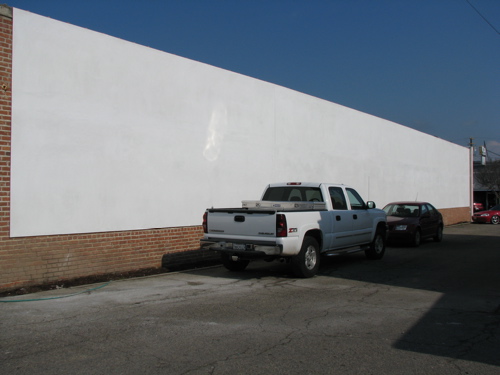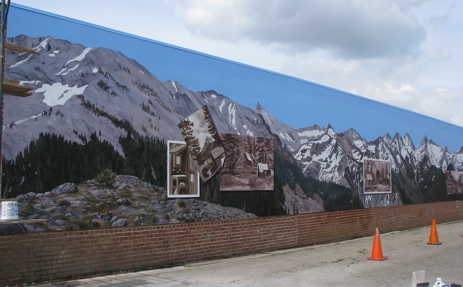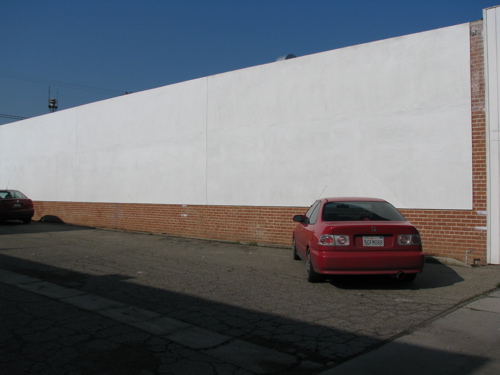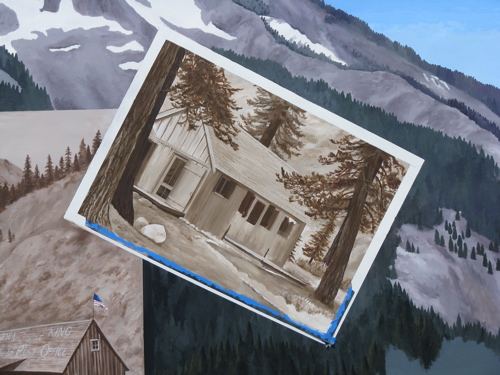The Garden Party. . .
. . . is sold out! If you are one of the lucky ones to have a ticket to this very enjoyable event, you will not be sorry. The Garden Parties I’ve been to in the past have been wonderful – nice evening outside in Exeter (no mosquitos there!), good food, great auction items, nice music, fun conversations, all around very pleasant evening.This will be auctioned off. I will probably have my hands over my ears, or perhaps my thumb will be in mouth.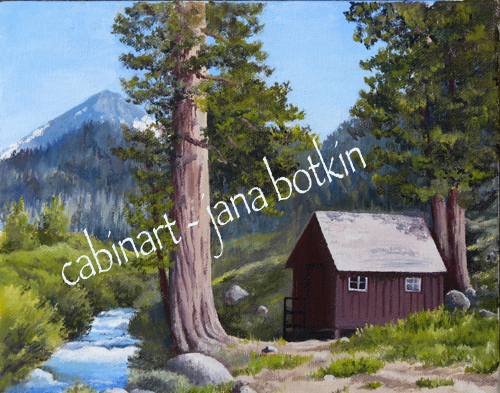 It is an 8×10 oil painting on wrapped canvas with no frame. The title is Honeymoon Cabin III or perhaps Honeymoon Cabin IV. The money will go Exeter, A Festival of Arts. This is the only place I give artwork!
It is an 8×10 oil painting on wrapped canvas with no frame. The title is Honeymoon Cabin III or perhaps Honeymoon Cabin IV. The money will go Exeter, A Festival of Arts. This is the only place I give artwork!
Mural, Day Fifty
Another day of many many visitors. I am now dragging my brush because I don’t really want it to be over yet! I “helped” Dora with her computer for awhile (yeah, right) and spent some time just staring and adding a thing or two and dinking a bit here and there. Mr. Stroben and his wife came by. He offered a few suggestions, which I greatly appreciated. Tom D. came by and wanted to offer some last minute suggestions. I forced a brush into his hand and will show you his contribution to the mural! Mike M. came by to visit, and I was moaning about my stupid brushes and irritating acrylic paint that will not behave like pencils. He handed me 2 very tiny brushes that he happened to have with him! Isn’t that a hoot?! LJ came by and helped me understand the contours of the mountains underneath the plain white patches of snow so that I can add some depth to them. Shane stopped by and a learned a bit of history of Mineral King and the basic differences between the National Park and the National Forest services. Here are the photos from today: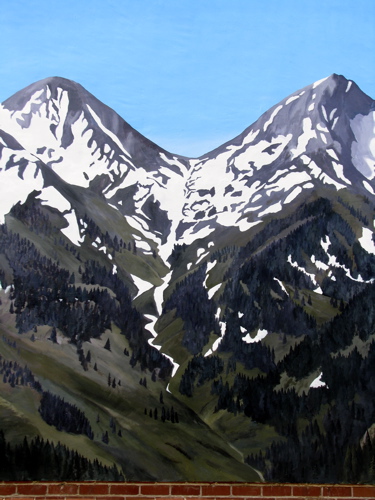 This probably doesn’t look any different to you, but it is new and improved. Part of the improvement was due to the extraordinary skill of emerging artist Tom D. Can you discern which 2 are his squiggles? (the color is terrible in this photo but is nice and green on the mural)
This probably doesn’t look any different to you, but it is new and improved. Part of the improvement was due to the extraordinary skill of emerging artist Tom D. Can you discern which 2 are his squiggles? (the color is terrible in this photo but is nice and green on the mural)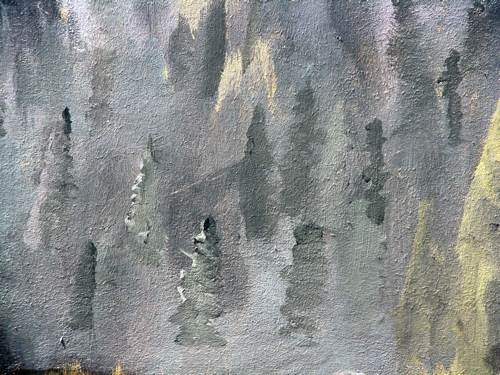
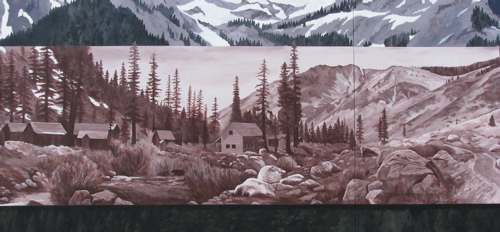 This may not look any different to you either, but I can assure you it too is new and improved (but not lemon scented). You need to see it in person to appreciate the detail. As usual in my art instruction history, Mr. Stroben was right. 😎
This may not look any different to you either, but I can assure you it too is new and improved (but not lemon scented). You need to see it in person to appreciate the detail. As usual in my art instruction history, Mr. Stroben was right. 😎
Mural, Day Forty-nine
Today was a day of many visitors. The most welcomed one might be LJ, my painting “coach”. We discussed the detail around Sawtooth, so I decided to drive there. (How many of you can say you have driven to Sawtooth??) With her help, I greatly improved the area from Empire to Mineral Peak, sorting out the rocks and ridges, adding shadows, erasing lines that don’t belong, and this is how it looks now:
 See how it was back in February??
See how it was back in February??
Mural, Day Forty-eight
Today was fun – lots of detailing, and a few hidden items, which will stay hidden for awhile! There may be a contest. There may be a prize. More will be revealed, both literally and figuratively! Meanwhile, big THANK YOU to Carmen and Caitlyn who picked up trash by the mural today. Caitlyn is 6 and it was her idea. I was thrilled, because trash and weeds were on my list of things to do before the Garden Party on Sunday!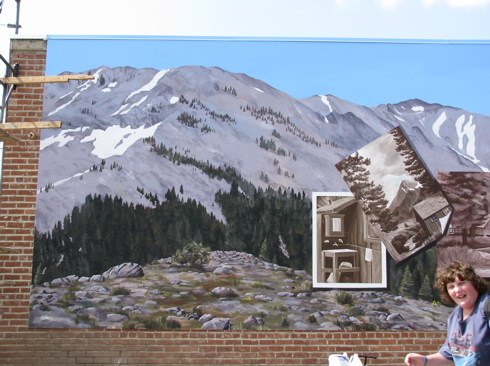 This is Shane, a friend I have made while painting. He appears to be taking my advice seriously that the faster one runs, the better the mural looks!
This is Shane, a friend I have made while painting. He appears to be taking my advice seriously that the faster one runs, the better the mural looks! 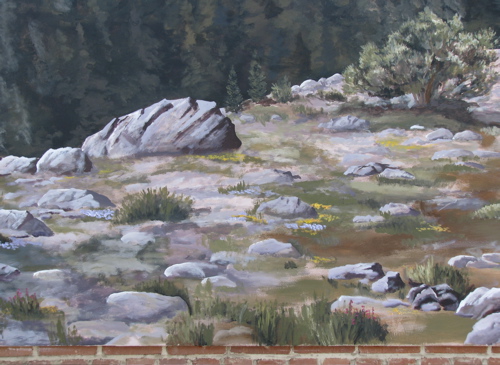
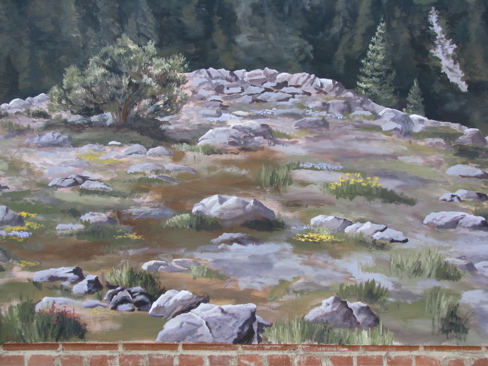
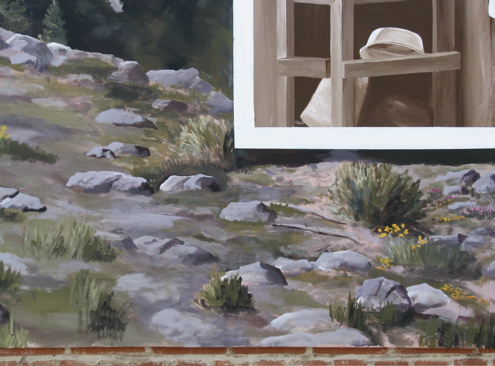

Mural, Day Forty-seven
Today I moved the truck out of the way and finished the mural. Maybe. Maybe not. There is paint on the entire wall now, and as the weather allows, I will fix this, improve that, clean up these, add those. More texture, better edges on rocks, fix fix fix. Here, look at the end: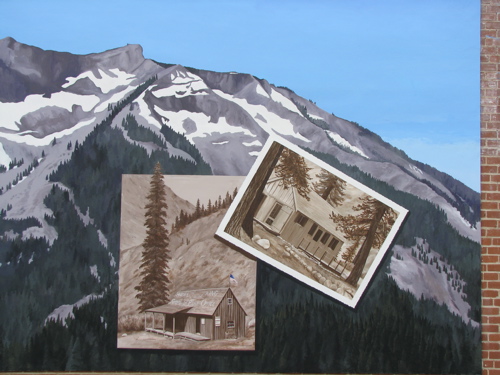 Now the fun begins – all the fine tuning and hiding the objects! People have been asking me about that since I started on February 4, and it will happen!
Now the fun begins – all the fine tuning and hiding the objects! People have been asking me about that since I started on February 4, and it will happen!
Mural, Day Forty-six
Good thing it isn’t really hot yet, because it IS really REALLY hot working on THE WALL. Phew. This morning I may have finished the “hill” – I hope it gives the viewer a sense of placement, a feeling of being grounded instead of just viewing mountains from a helicopter. And today I was asked again about the “postcards” as in “Are you going to just leave those insets there?” I used extraordinary restraint in my response because dozens of rude remarks flashed through my mind such as “How did you pass your driver’s test?” or “You got any spray paint with you?” or “Why don’t you just try to peel them off?” or “yeah, I spent too much on them at Kinko’s” or “Bite me”. Not sure what I said, but I hope it was polite. I don’t usually feel polite when it is really hot out. The names are mostly gone with one exception:
The names are mostly gone with one exception: 
Mural, Day Forty-five
It is relatively hot out today which causes the paint to dry much too fast in the palette, on the wall and in the brush. The only reason I tried to paint is that Steve Fujimoto, renowned Visalia Times-Delta photographer, came to “shoot” me in action. These photos are to accompany an article that will appear in the May issue of Tulare County Life magazine. That will take place the first Tuesday in May with the day’s copy of the Times-Delta. For those of you out of the area, perhaps you can find it here: http://www.visaliatimesdelta.com/ So today I just added some texture to Ashley’s hill and began encroaching on the list of names. When the weather cools back down, I’ll go finish this area.
Mural, Day Forty-four
Wow, can it be?? Today I began detailing that hill on the lower left because the final “snapshot” is finished. Maybe. (A man asked me again how I got those photos up on the wall – his buddy blurted out “With her paintbrush, Dummy” or something equally ungracious.)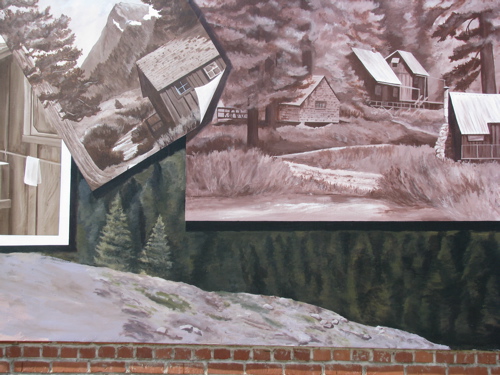 Does this look like dirt, rocks, growies and sticks?
Does this look like dirt, rocks, growies and sticks? Here is a look at the last (sob, sniffle) “snapshot”. It might need a little more tightening up. And here is one that I have straightened for you:
Here is a look at the last (sob, sniffle) “snapshot”. It might need a little more tightening up. And here is one that I have straightened for you: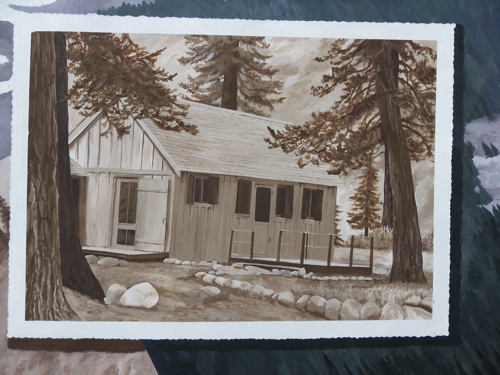 See the ruffled edge? It surprised me how random those edges were in the snapshots from the 40s, although I am sure there had to be some that had symmetrical ruffles.
See the ruffled edge? It surprised me how random those edges were in the snapshots from the 40s, although I am sure there had to be some that had symmetrical ruffles.
